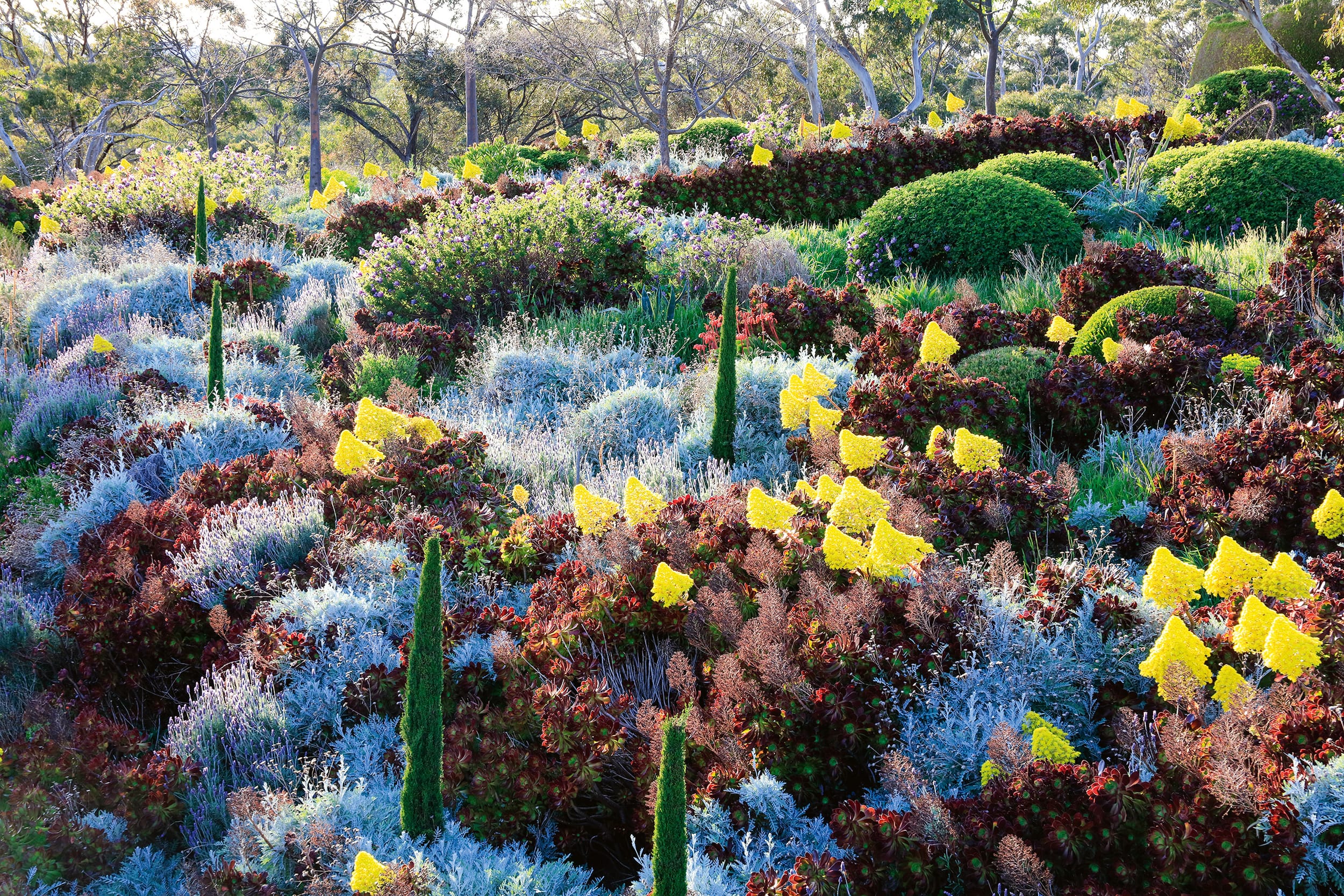
In the toughest conditions – “climate change on steroids” – Kurt Wilkinson has developed radical ideas about design and beauty in his South Australian garden.
Words Christine McCabe
KURT Wilkinson’s garden surges downhill like a wave or a bushfire, popping here and there with red and blue as it cascades, plants tumbling over each other. Some might call it slightly out of control, others a mesmerising painting in plants, a Mediterranean hillside as conjured by Jackson Pollock.
Imagine a broad river of russet red tree aeoniums flowing through undulating mounds of silver-leaved Centaurea gymnocarpa festooned with amethyst flowers like stars. Popping up here and there are French lavenders, cardoons and faithful old aggies (agapanthus) lapped by golden grasses. Time-worn aloes sit atop gnarly stems, somehow resembling palm trees. A five-metre-tall dead agave flower spike doubles as a piece of contemporary sculpture. And amid all this inspired chaos rise smoothly clipped domes of melaleuca and native hibiscus juxtaposed with slender Italian pencil pines pointing like fingers to the sky.
It’s a garden that tends to swallow visitors whole. The effect is dizzying, a barrage of plants and weedy grasses that in adverse conditions have managed to knit themselves together like a Persian carpet.
“I love long vistas,” says Wilkinson, “with plants popping up like fireworks.” He describes his garden “as wild as f—”. But it’s been a tough journey to arrive at this feral tapestry, requiring an unwavering commitment to a singular vision that’s captured thousands of Instagram followers and the attention of leading British garden designers.


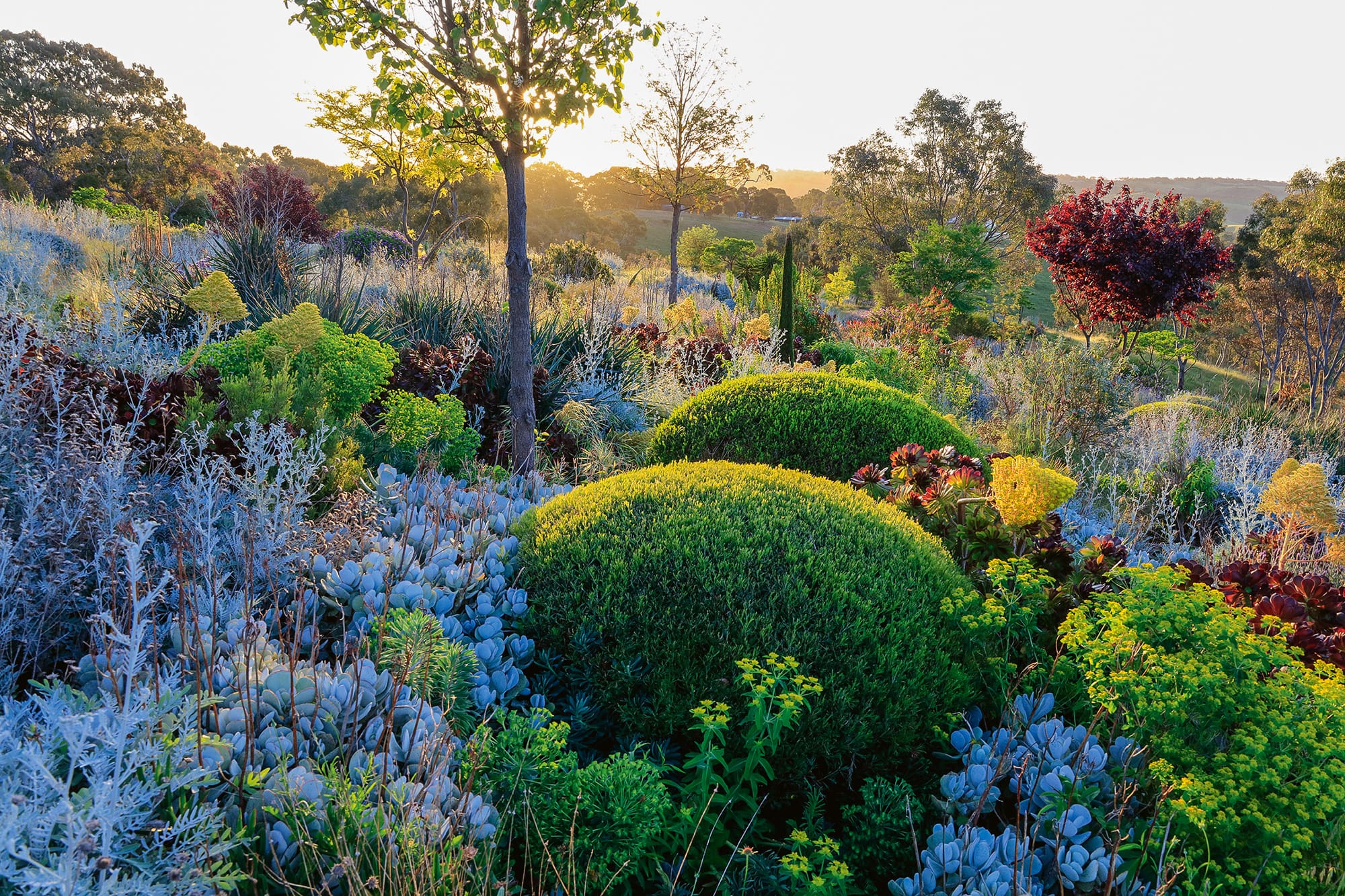
Kurt Wilkinson on his Adelaide Hills property; clipped domes of honey myrtle add curvaceous structure. Portrait by Kelsey Zafiridis. Garden photography by Kurt Wilkinson.
His three-acre property Yalamurra lies in the drier reaches of the Adelaide Hills as the ranges swing north towards the Barossa Valley. The sleek house with an infinity pool cantilevered off the front commands long views to the distant plains. Wilkinson shares the house with his wife, Lauren, their children and two boisterous Dobermanns. Less than an hour from the CBD, the property nevertheless feels very remote, the national park next door contributing to a sense of isolation. Kangaroos nudge Wilkinson’s high macropod-proof fence and cockatoos dangle like Christmas baubles from whispering eucalypts.
The scene could not be more Australian: relaxed, slightly dishevelled, and entirely out of keeping with Wilkinson’s early career as a gardener specialising in formal European design.
I first met Wilkinson when he came to pass verdict on my decrepit, century-old cypress hedges. I was desperately in need of a qualified and sympathetic hedge-trimmer and Wilkinson was considered the best; his reputation for precision whispered among gardeners across the Adelaide Hills, his services fiendishly difficult to procure. I feared my hedges’ intense informality and general disregard for symmetry would offend him. Quite the contrary, for I was lucky enough to meet Wilkinson just as his design ethos was taking a sharp turn to the wild side.
Since then our conversations have never been dull. Well read, with a hyper curious mind and never shy to express a controversial opinion or six, Wilkinson is engaging company. A visit to his garden is a peep into a highly individual mind.
A self-trained landscape designer, Wilkinson studied biochemistry and organic chemistry at university, falling into horticulture by accident after helping a friend with his gardening round. Always ready to go at something full pelt, Wilkinson quickly became obsessed with structure and was soon specialising in the very precise maintenance of hedges and formal gardens.
It was the time of “box hedging and iceberg roses”, he says. “If you were radical you might pop in Seduction or Gold Bunny (creamy pink and yellow roses) … then you were right on the edge.”
Over time he observed that “plant health was often suffering” and using his tertiary training began scouring scientific articles and books. “My ethos was shifting,” he says. “Formal design requires huge input and control” but can result in “an almost sterile garden that nature is intent on overthrowing”.
Even so, Wilkinson remained wedded to “the status” of the formal garden; it was the world in which he worked.
Two things were to finally change this approach: working with South Australian garden designer Virginia Kennett, who introduced him to the world of succulents – plants he initially “hated” – and in 2012 buying Yalamurra, located in the northern Adelaide suburb of Yattalunga near the delightfully named Humbug Scrub.
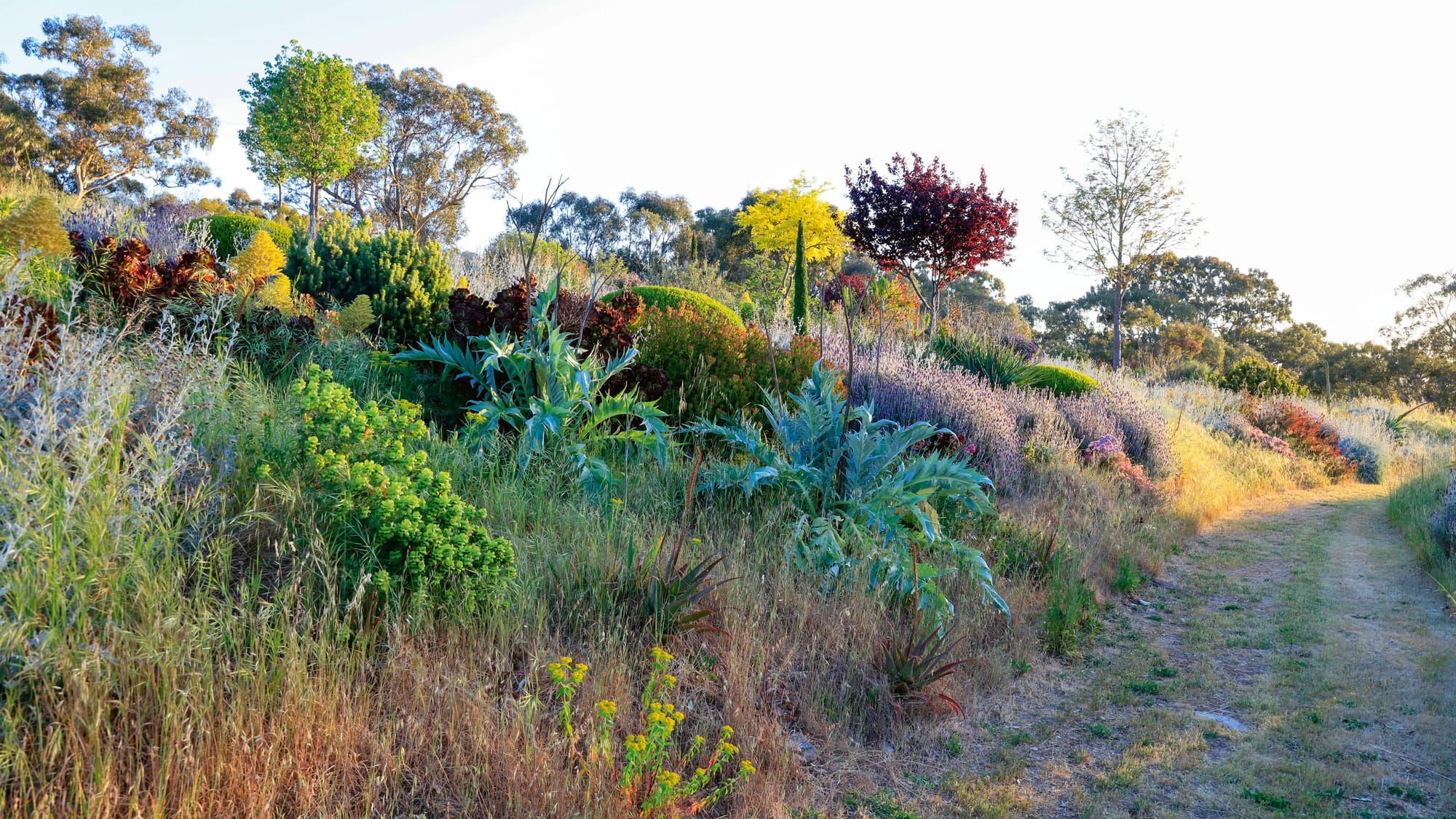
The blank-canvas site looked promising and although hotter and drier than the leafier areas of the Adelaide Hills, known for its lush cool-climate gardens, Wilkinson was convinced he could make a formal garden that would serve as a calling card for clients. “I began slowly just pottering,” he recalls.
He made wide paths up and down the steep site to bring in machinery, and erected a kangaroo-proof fence. Then came the trees: ornamental Chanticleer pears, junipers, Norfolk pines. Almost everything died except the succulents and a few pears. “Nature just slapped me in the face,” he says.
In three short years “I turned my garden into a war zone, a bomb site, a moonscape”, he recalls. “I’m a good gardener – what was happening?”
It was Phytophthora, a water mould that causes root rot and destruction globally. There’s a warning sign by the national park next door but “I never bothered to read it”, he laughs. The entire site at Yalamurra is affected by the mould.
Wilkinson’s struggling garden became an all‑consuming experiment, a process of trial and error to see what would survive. In went native tube stock, Leucadendron and geraniums. Even the latter, unkillable in most gardens, died.
Wilkinson looked to the few plants he had inherited from the previous owner. Honey myrtle (Melaleuca nesophila) reminded him of Japanese box, so he began trimming the plants into neat domes, later successfully moulding a curvaceous hedge to conceal sheds and fencing.
He was all set to pull out several unprepossessing native hibiscus (Hibiscus heterophyllus) when he reached for his clipping shears instead. “Now they are my favourite, so fluffy, like little clouds,” he says, “and I can use the plants in so many different ways, coppiced or topiarised.”
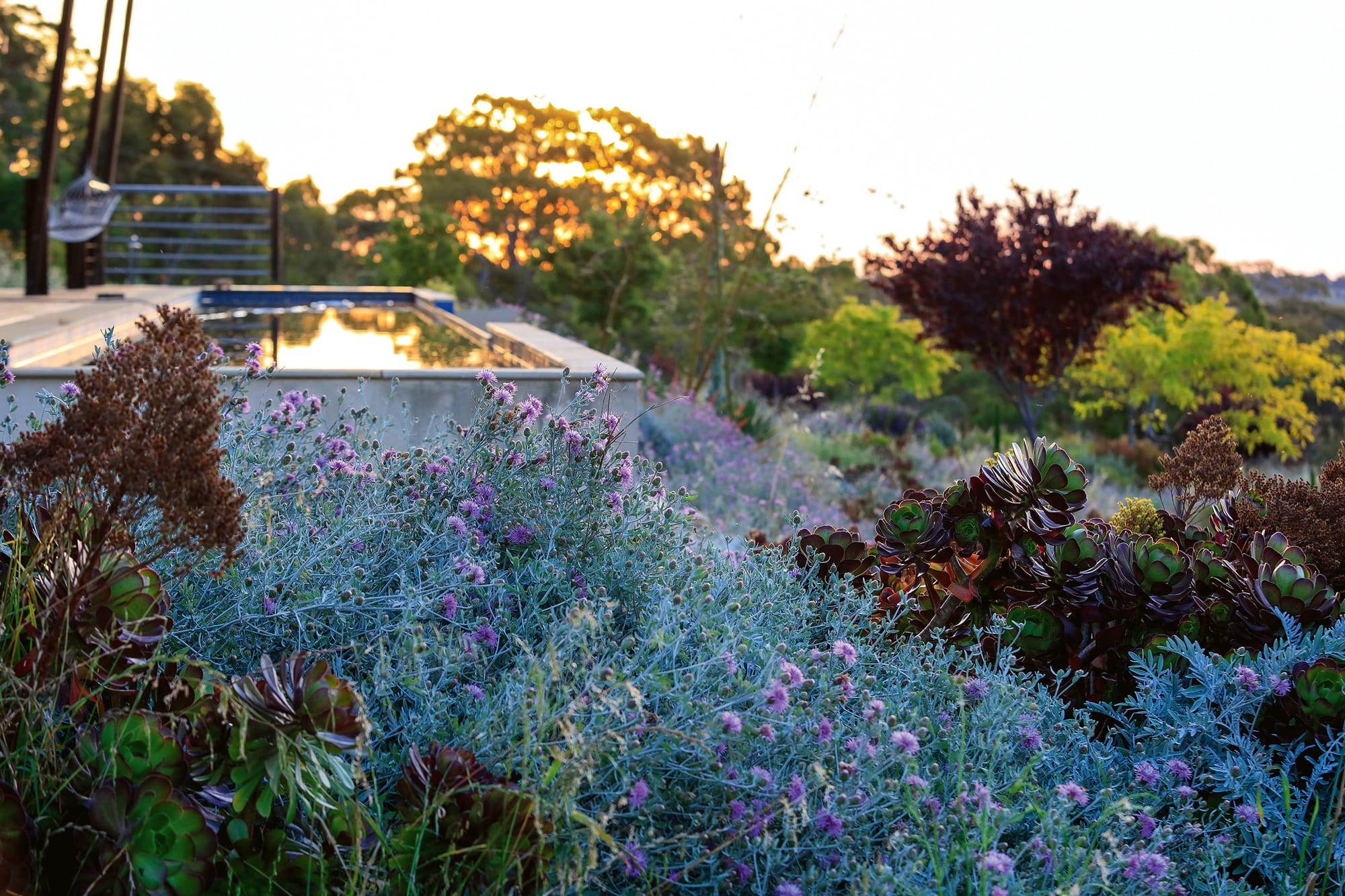
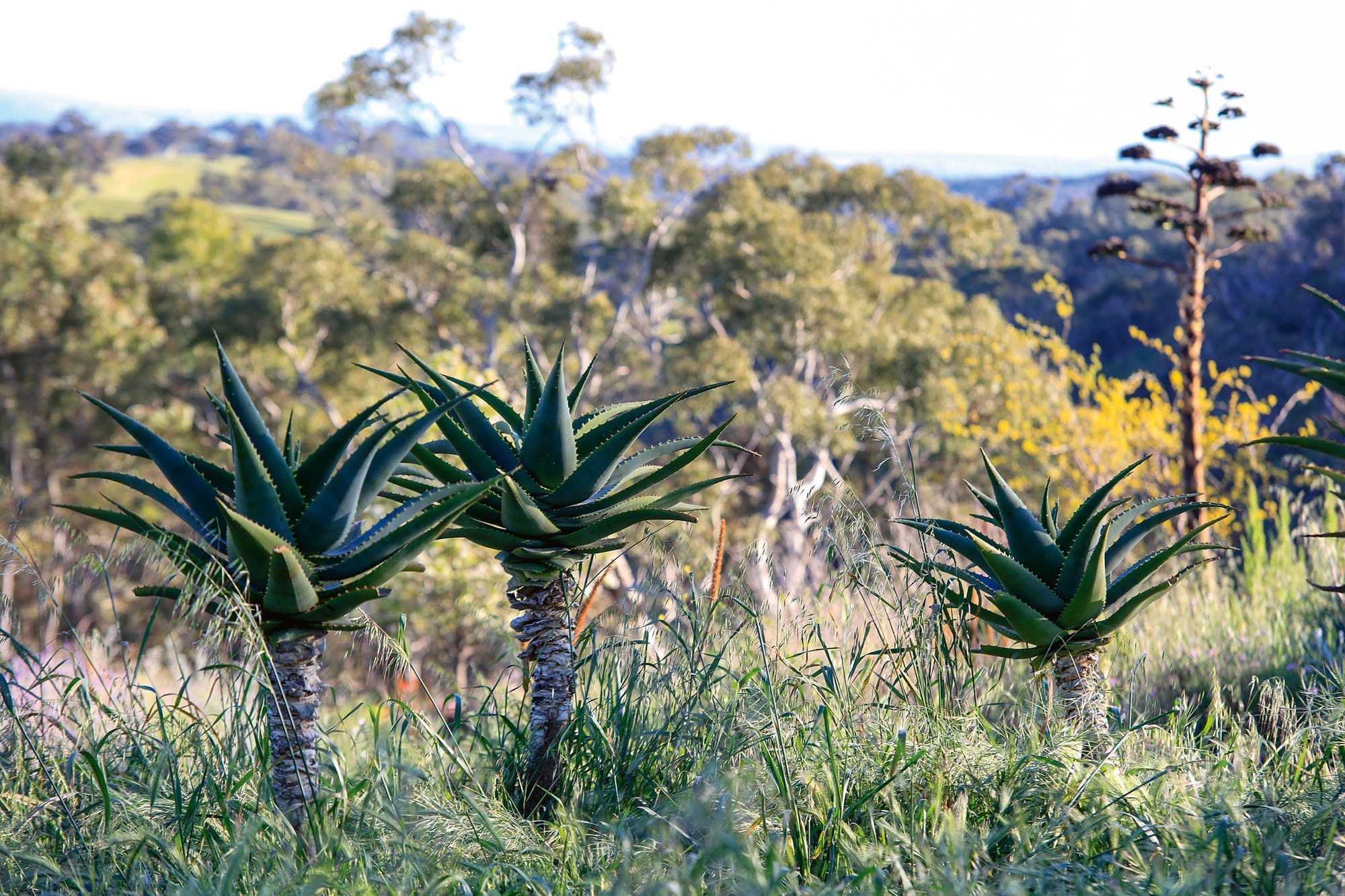
The Aeonium arboreum (tree houseleeks) were already established and seemed to be doing well so Wilkinson took to breaking off stems and sticking them straight into the ground. Now there are hundreds. This remains Wilkinson’s propagation modus operandi, popping cuttings directly into the ground in vast numbers to improve the survival ratio.
Mown paths of dry grass wend through banks of plucky plants that have withstood the water-mould challenge: aloes with rich red flower spikes, artichokes, agaves and cardoons, the latter old-fashioned plant providing wonderful architectural structure and gorgeous rich purple flowers loved by bees. Even parsley is grown in blocks and let run to seed for its airy flower heads.
Pig’s face is a stand-out performer. “I once hated the apricot and hot pink flowers,” says Wilkinson, “but I’ve grown to love them and the plants flower just before Christmas when there isn’t much else.” Against these dry-climate stalwarts, Queen Anne’s lace, an unlikely survivor, adds a soft counterpoint.
Along with a massive eucalypt behind the house, trees that have proved their worth include the pretty Gleditsia, southern silky oak (Grevillea robusta), ornamental pears and plums – and one solitary crepe myrtle.
The thistle-like Centaurea, hailing from the hotter, drier parts of Italy, is a real hero plant; there are hundreds, if not thousands, all descended from a single cutting from a client’s garden. “It’s become a great filler plant, useful in suppressing weeds.”
Yet weeds also play a role. In late spring, one of the key threads in Wilkinson’s garden tapestry is dry wild grass. Left to grow unhindered among the “cultivated” plants, it adds a rich textural element and golden airiness that’s a brilliant foil for the flowers. “Traditional” gardeners find the grass “confronting”, says Wilkinson, but he couldn’t care less. Every plant, “even weeds are solar panels taking the sun and converting that into sugar and pumping that sugar into the soil,” he says. (Interestingly, in Britain the notion of the weed is being revisited. Many of these plants, if suitably corralled, are useful soil conditioners, bee magnets and bird food.)
Throughout his career Wilkinson has intentionally avoided garden design books. “If I’d found out about Paul Bangay it would have ruined me, I would have joined the cult and never escaped …”
Even today he avoids studying the work of other designers, instead reading philosophy. At Yalamurra he gardens for himself without fear or favour. No clients to please. No outside influences to distract him. And that’s the real success of this garden. It’s Wilkinson’s alone, a joyous “feedback loop” with layers of plants doing their own thing, and forgotten flowers popping up here and there to provide unexpected vignettes.
Wilkinson observes these precious moments through a camera lens, taking as many as 5000 photos a week. “Photographing the garden has taught me so much about design,” he says, “I take five photos of the same scene from different orientations then consider which I prefer and why.”
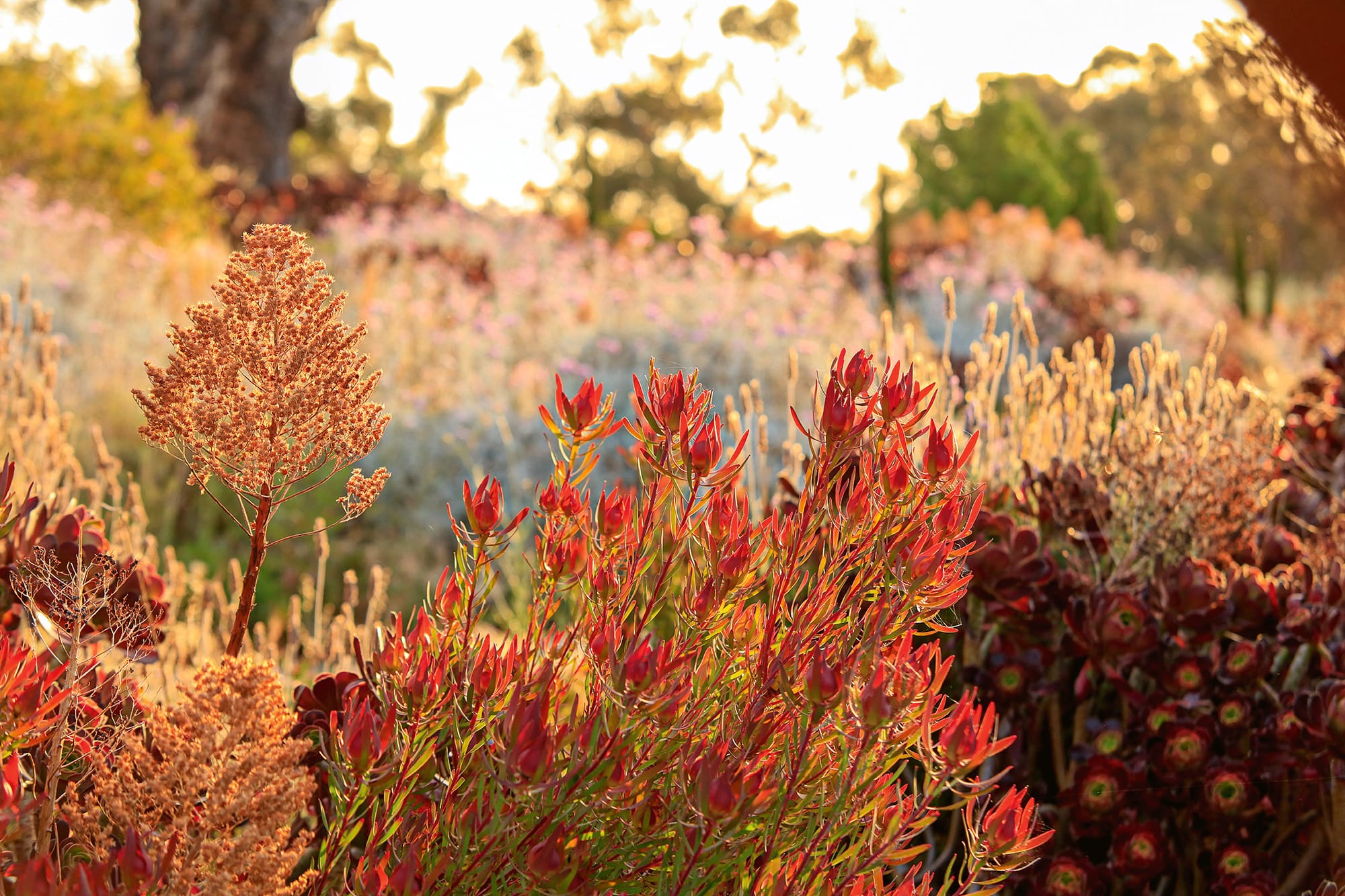
Images posted to Instagram connect him with a global community of gardeners and well-known designers including Noel Kingsbury in Britain, with whom he joins in podcasts and webinars.
“There were many times I could have walked away from Yattalunga,” Wilkinson admits. “But I am now obsessed. This garden is as close to a complete ecosystem as any garden you will find anywhere … it operates on almost no energy input, including zero water … with the exception of me editing and planting more cuttings.”
This makes Yalamurra an excellent example of adapting to a changing climate. “This place is climate change on steroids,” he says. But he rejects the notion of it being a truly wild garden. There’s no such thing, he says. “Nature has no interest in aesthetics. This is contrived wild. Every garden needs adjustment and guidance to emphasise and exaggerate certain aspects.”
I keep returning to that idea of a Pollock painting. Whether by intent or out of necessity, Wilkinson has made a garden using an “all-over” method of planting. Unlike a formal garden, which he says you can read in a moment, here there is no single focal point, no axes or allées. You could wander about his garden for days and always find a hundred new things, and new ways of seeing.